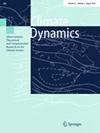MetUM GA7和GC3配置下全球和区域海温偏置对东亚夏季风的影响
IF 3.7
2区 地球科学
Q2 METEOROLOGY & ATMOSPHERIC SCIENCES
引用次数: 0
摘要
摘要对英国气象局统一模式全球大气7.0 (GA7)和全球耦合3.0 (GC3)配置的气候长度试验进行了评价,并对东亚夏季风(EASM)的模拟进行了观测和再分析。结果显示了系统的模式偏差,例如高估了中国南方的降雨量而低估了中国北方的降雨量,这表明季风没有向北渗透。我们评估了太平洋、印度洋和大西洋三个区域的海表温度(SST)条件的区域误差对EASM的影响。GC3配置中的全球海温偏置极大地改变了EASM季节周期:在季风早期/中期,EASM晚向北推进,季风早退,这也减少了中国北方大部分地区的降雨量。EASM区域的季节性降水偏倚与北太平洋副热带高压的位置和强度变化有关,而北太平洋副热带高压的位置和强度变化与局地蒸发和水汽向华南输送的偏倚有关。El Niño-Southern涛动(ENSO)和印度洋偶极子(IOD)遥相关路径中的GC3偏置也影响EASM偏置。GC3偏置减弱了ENSO与东亚东部的遥相关,并在El Niño发展过程中引起中国东南部强烈的干偏置。本文章由计算机程序翻译,如有差异,请以英文原文为准。
Effect of global and regional SST biases on the East Asian Summer Monsoon in the MetUM GA7 and GC3 configurations
Abstract Climate-length experiments of the Met Office Unified Model Global Atmosphere 7.0 (GA7) and Global Coupled 3.0 (GC3) configurations are evaluated against observations and reanalyses for the simulation of the East Asian summer monsoon (EASM). The results show systematic model biases, such as overestimated rainfall over southern China and underestimated rainfall over northern China, suggesting a monsoon that does not penetrate northward enough. We evaluate the effects on the EASM of regional errors in sea-surface temperature (SST) conditions in three regions: the Pacific, the Indian, and the Atlantic Oceans. The global SST biases in GC3 configuration substantially shift the EASM seasonal cycle: a late northward progression of the EASM in the early/mid-monsoon season, and an early retreat of the monsoon that also reduces rainfall over most of northern China. The EASM seasonal rainfall bias in the EASM region is linked to changes in the locations and strength of the western North Pacific subtropical high, which is associated with biases in local evaporation and moisture transport towards South China. GC3 biases in the El Niño-Southern Oscillation (ENSO) and the Indian Ocean Dipole (IOD) teleconnection pathways also influence the EASM biases. GC3 biases weaken the ENSO teleconnection to the EASM and cause a strong dry bias in southeast China during developing El Niño.
求助全文
通过发布文献求助,成功后即可免费获取论文全文。
去求助
来源期刊

Climate Dynamics
地学-气象与大气科学
CiteScore
8.80
自引率
15.20%
发文量
483
审稿时长
2-4 weeks
期刊介绍:
The international journal Climate Dynamics provides for the publication of high-quality research on all aspects of the dynamics of the global climate system.
Coverage includes original paleoclimatic, diagnostic, analytical and numerical modeling research on the structure and behavior of the atmosphere, oceans, cryosphere, biomass and land surface as interacting components of the dynamics of global climate. Contributions are focused on selected aspects of climate dynamics on particular scales of space or time.
The journal also publishes reviews and papers emphasizing an integrated view of the physical and biogeochemical processes governing climate and climate change.
 求助内容:
求助内容: 应助结果提醒方式:
应助结果提醒方式:


